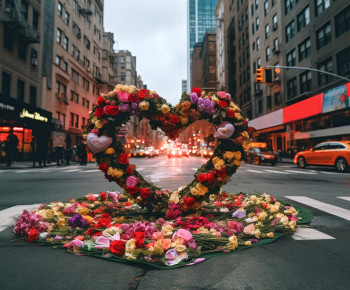Floristry without borders: how bouquets become art objects

Floristry has always existed at the intersection of craft and art. Flowers are a natural material, beautiful in their own right, but it is the florist who transforms them into a story, an emotion, and an image. While a bouquet was once perceived as a traditional gift or interior design element, today more and more florists are working in a signature style, where arrangements become true art objects.
Today's client doesn't just want "12 roses in a package." They seek uniqueness, emotion, a visual code that reflects their character and lifestyle. A bouquet becomes a language of communication and part of the cultural space.
A bouquet as a form of self-expression
Traditional floristry was all about repetition: roses, tulips, and gerberas in familiar combinations. But new generations of clients are creating a demand for unique solutions.
- Emotion instead of a "set of flowers". A modern bouquet is more than just a selection of plants, but a way to convey a mood: lightness, drama, minimalism, or bold vibrancy.
- A signature. Like artists or designers, strong florists develop a recognizable style: sometimes it's minimalism and geometry, sometimes lushness and color experimentation.
- Visual culture. On Instagram, Pinterest, and TikTok, bouquets have become part of content culture. A beautiful art bouquet is not only a gift but also a photograph the client is proud to share.
Floristry and the art scene
Floristry is increasingly integrated into the world of art and design.
- Installations in museums and galleries. Large-scale arrangements of fresh or dried flowers become part of exhibitions, creating a new atmosphere in the space.
- Fashion and photo shoots. Bouquets are transformed into accessories for fashion shows, photo shoots, and advertising campaigns. Flowers in the hands of models are perceived not as decoration, but as part of the image.
- Urban art. Festivals, floral sculptures on the streets, and the decoration of squares—flowers become part of the urban environment.
- Performances. The process of assembling a bouquet becomes a show, where the audience witnesses the composition being created. It's akin to theater, where the florist becomes the actor.
Why are art bouquets in demand
- Uniqueness. In an era of cookie-cutter solutions, art bouquets are valued for their uniqueness. Each one is a one-of-a-kind.
- Emotional impact. Such a bouquet evokes not just joy, but a powerful impression comparable to a visit to an exhibition or concert.
- Increased value. Art floristry operates in the premium segment: customers pay not for the "quantity of flowers," but for the idea, aesthetics, and experience.
- Expanded audience. Art attracts new clients—those previously uninterested in floristry but seeking unusual ways to express themselves.
Floristry as a new language
Today, floral arrangements have become part of the cultural code.
- On social media, art bouquets garner thousands of likes and shares, setting new trends.
- In business, companies use floral art objects for branding and events.
- In interiors, compositions that blend floristry and design become focal points in spaces ranging from apartments to restaurants.
Bouquets are no longer just "flowers" and are becoming a new form of communication, where floristry speaks the same language as fashion, music, and contemporary art.
The future of floristry as an art
- Growing collaborations. Florists will work with artists, architects, and fashion designers to create cross-disciplinary projects.
- Interactive art objects. Living compositions that change over time will engage viewers in dialogue.
- Eco-consciousness. Upcycling, recycled materials, dried flowers, and local plants will become part of art floristry.
- Digitalization. NFT compositions and virtual floral works will emerge, which can be collected in the digital space.
Conclusion
Floristry is moving far beyond the traditional "buying a bouquet for a holiday." It's becoming a fully-fledged art form, where a bouquet is an art object, a symbol, an emotional statement. For a florist, this is a chance not just to earn money, but to create a culture and set trends.
Those who dare to work at the intersection of business and art will be able to attract a new audience and reach a completely new level in their profession.
Your experience matters! Take a short survey and see what answers other flower business representatives gave. Take part